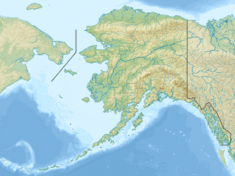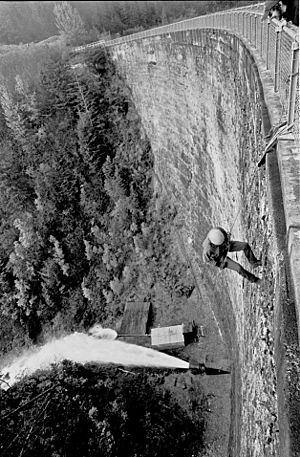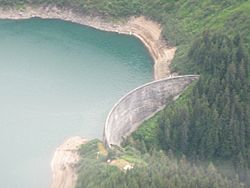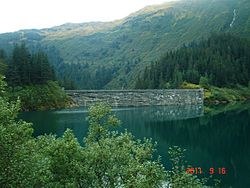Salmon Creek Dam facts for kids
Quick facts for kids Salmon Creek Dam, Alaska |
|
|---|---|
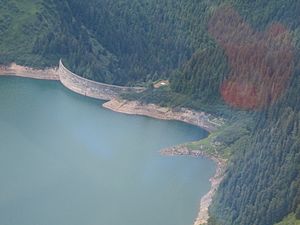
Aerial view of Salmon Creek Dam in Juneau, Alaska
|
|
|
Location of Salmon Creek Dam, Alaska in Alaska
|
|
| Official name | Salmon Creek Dam |
| Location | Juneau, Alaska, USA |
| Coordinates | 58°20′30″N 134°24′05″W / 58.34167°N 134.40139°W |
| Construction began | July 24, 1913 |
| Opening date | August 13, 1914 |
| Owner(s) | Alaska Electric Light & Power (AEL&P) |
| Operator(s) | AEL&P |
| Dam and spillways | |
| Type of dam | Constant-angle concrete arch dam |
| Height | 175 ft (53 m) |
| Length | 645 ft (197 m) |
| Width (base) | 6.5 ft (2.0 m) at top and 47.5 ft (14.5 m) at base |
| Reservoir | |
| Creates | Salmon Creek Reservoir |
| Total capacity | 18,000 acre⋅ft (22,000,000 m3) |
| Catchment area | 7.5 sq mi (19 km2) |
| Surface area | 192 acres (78 ha) |
| Power station | |
| Operator(s) | AEL&P |
| Commission date | 1914 |
| Installed capacity | 6.7 MW |
| Annual generation | 29.5 GWh |
| Multi-purpose use | |
The Salmon Creek Dam is a concrete arch dam located on Salmon Creek, about 3 miles (5 km) northwest of Juneau, Alaska. It was built in 1914. This dam is special because it was the world's first "constant-angle arch variable radius dam." This design was so good that over 100 similar dams have been built around the world since then.
The dam was originally built by the Alaska-Gastineau Mining Company. They needed a lot of electricity for their mining work. Today, the dam still works perfectly to create hydroelectric power. It also helps provide drinking water for Juneau city and supports fishing. Using the constant-angle design saved about 20% on building costs because it needed less concrete. The dam and its power plants were considered amazing engineering achievements when they were first built. The Alaska Electric Light & Power (AEL&P) company operates and takes care of them.
Contents
Where is Salmon Creek Dam?
The Salmon Creek Dam is in a beautiful, narrow valley surrounded by forests. Salmon Creek flows from the Salmon Creek Reservoir southwest for about 3 miles (4.8 km) until it reaches the Gastineau Channel.
The dam is located at the end of a special tram-way. This tram-way was built by the Alaska Gastineau Mining Company to carry materials for building the dam and its power stations. The power from the dam was used for mines located about 6 miles (9.7 km) south at Sheep Creek.
The creek itself is about 3 miles (4.8 km) long within its watershed. The stream bed has large gravel and rocks. The water is usually about 1.5 feet (0.46 m) deep and the stream is about 30 feet (9.1 m) wide. Hills with steep slopes surround the area, rising over 980 feet (300 m) above sea level.
How Arch Dams Changed
Long ago, even during the Roman period, people knew that curved dams (arch dams) were good at holding back water. In the 1800s, with new concrete technology, engineers found ways to build arch dams that used less material and cost less money.
An arch dam is a curved wall that leans upstream. It pushes the water's pressure onto the sides of the valley. The best shape for a constant-angle arch dam in a "V"-shaped valley has a curve of 133 degrees. This idea led to the "constant-angle" (or variable radius) arch dam, which could be built thinner.
This new design was first used in North America in 1913 with the Salmon Creek Dam, which finished in 1914. Bartlett L. Thane, a mining engineer, was key in bringing this design to the Alaska-Gastineau Mining Company. Lars Jorgensen developed the specific design for the constant arch dam. However, AEL&P credits their Chief Engineer Harry L. Wallenberg for the Salmon Creek Dam's design.
How the Dam Was Designed
There are two main types of arch dam designs: constant-radius and constant-angle. The constant-angle design is more complex.
In a constant-angle dam, the central opening angle stays the same. But the arch's radius (its curve) gets wider from the bottom to the top. This wider curve at the top matches the wider canyon walls. This design saves a lot of construction material compared to the constant-radius design.
Lars R. Jorgenson figured out that the most cost-effective dam design had an opening angle of 133.6 degrees, using the least amount of concrete. The Salmon Creek Dam used a similar idea, with a constant opening angle of 113 degrees. Its radius changes from 147.5 feet (45.0 m) at the bottom to 331 feet (101 m) at the top. The "V" shape of the gorge at Salmon Creek was perfect for this type of dam.
The dam was designed to handle a lot of pressure from ice, especially in Alaska's cold climate. The dam is 47.5 feet (14.5 m) wide at its base and narrows to 6.5 feet (2.0 m) at the top. It stands about 168 feet (51 m) tall. The ground at the dam's base was a flat, rocky bed, which made it easy to build the foundation without a lot of digging.
The dam's top is 640 feet (200 m) long from one side of the valley to the other. The reservoir can hold about 18,000 acre-feet (22,000,000 m3) of water when full. A steel pipe, 4 feet (1.2 m) wide, was placed at the dam's middle base to act as a spillway (where excess water flows out). The top of the dam is 343 feet (105 m) above sea level. The reservoir covers an area of 192 acres (78 ha), and its water comes from a 7.5 square miles (19 km2) catchment area.
Building the Dam
Construction of the Salmon Creek Dam and its two power stations began in May 1912. Workers first started building the lower power house near the Gastineau Channel. A power line was set up from there to the mines by March 1913. The dam itself started being built in April 1913.
To build the dam, facilities were set up upstream. Here, rocks were crushed to make aggregates (small and large pieces of rock). These aggregates were mixed with cement and a little bit of lime to make the concrete for the dam. The first concrete was poured on July 14, 1913. The dam was finished in just 13 months, on August 13, 1914. About 54,000 cubic yards (41,000 m3) of concrete was used, poured at a rate of 400 cubic yards (310 m3) per day.
Between 1912 and 1914, two power stations were built to use the water from the reservoir.
- The first one, 'Powerhouse 2', was about 1 mile (1.6 km) downstream from the dam. It had two units, each making 1.5 MW of power.
- Water from Powerhouse 2 flowed through a 10,000 feet (3,000 m) long channel to the second power station, 'Powerhouse 1', located near the Gastineau Channel. This power house also had two units, each making 1.5 MW.
Together, the two power stations could generate 6,000 kW (8,000 hp) of power. Near Powerhouse 1, buildings like offices, workshops, sawmills, and housing for staff were also built.
Keeping the Dam Strong
Over the years, the dam and its power stations have been repaired and updated many times. Powerhouse 2 was damaged by a fire in 1923. It was fixed in 1935 but finally stopped being used in 1998.
The dam itself also needed repairs as it got older. In 1967, old concrete was removed, and new, strong concrete was added to the dam's upstream side for the top 45 feet (14 m).
The lower power house also had major updates. It was closed in December 1974 because it was too expensive to run. But in 1984, a new power plant was built right next to the old one. This new plant can generate 6.7 MW of power.
Benefits of the Dam
Even though the Salmon Creek Dam was first built to make electricity for mining, it now serves many purposes. It provides power, drinking water, and supports fish.
Making Electricity
The updated dam and the new power plant at the lower site are fully working. The power station generates 29.5 GWh of electricity each year. This provides almost 10% of Juneau's electricity needs. The Alaska Electric Light and Power company manages the system.
Providing Drinking Water
The Salmon Creek Reservoir is an important source of drinking water for Juneau. Water is taken from near the power plant. This water is then sent to a treatment plant where it is filtered, cleaned with chlorine, and adjusted for pH. After treatment, it is sent to the city. This system started in 2015. The reservoir also acts like a large tank where chlorine can mix with the water to kill any harmful germs before it goes to the city. This system can supply 2,000,000 US gallons (7,600 m3) of water. The water is generally clean, and its quality is checked every month to meet standards set by the EPA and Alaska Department of Environmental Conservation.
Supporting Fish Life
In 1880, Salmon Creek was named by Richard Harris and Joe Juneau, who were looking for gold. Local Tingit people called it Tilhini, meaning "dog salmon."
In 1917, efforts were made to help fish grow in the Salmon Creek Reservoir. About 50,000 young fish (fry lings) were put into the reservoir with help from the Alaska Fish and Game Club. This helped increase the number of salmon in the reservoir. People reported that when the lake opened for fishing, the fish were about 6 inches (150 mm) long.
Today, Salmon Creek Reservoir is open for bait fishing all year. Many types of salmon and other fish live there, including Dolly Varden, Brook Trout, Freshwater Trout, Chum Salmon, and Coho Salmon.
Images for kids


